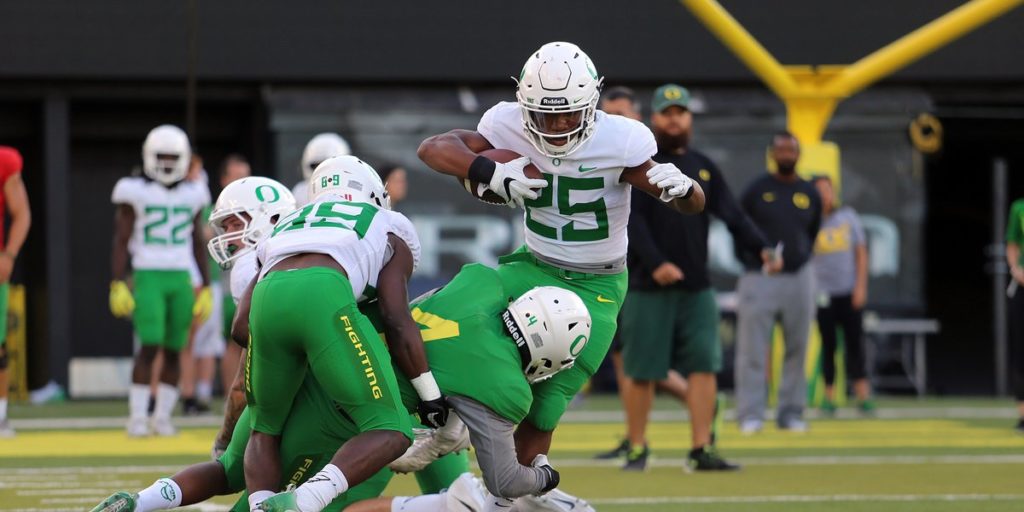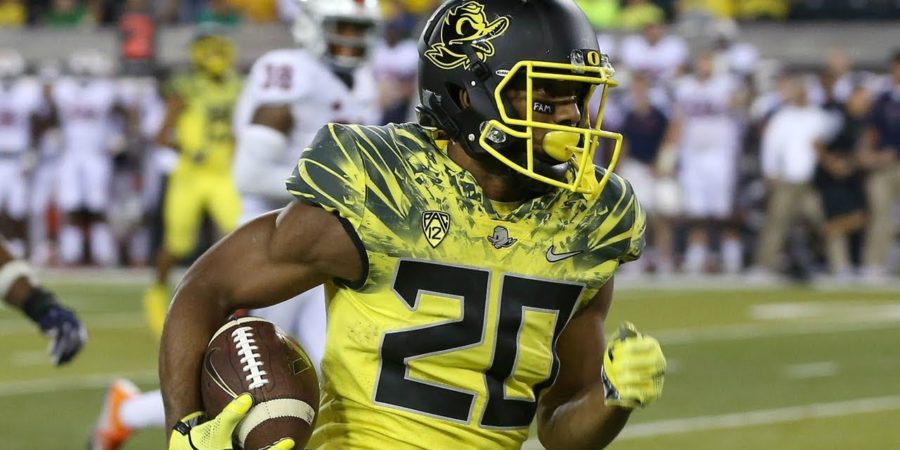Behold! Football season is nigh!
Believe it or not, mere weeks separate us between now and the start of fall camp for the Oregon Ducks. As preseason camp fast approaches, we at WFOD will be rolling out a series of previews to help fully prepare you for the upcoming season.
Sunday marks the continuation of our Fall Camp Questions series, which aims to address the most pressing questions surrounding each position group in the build up to the 2018 campaign.
Today’s question…
Is Tony Brooks-James equipped to be Oregon’s lead back?
After four incredible years as the starting running back at Oregon, Royce Freeman is off to the NFL after he was selected in the third round of this past year’s draft by the Denver Broncos. While Freeman may not have had the same number of opportunities to play in primetime games compared to former record-setting backs LaMichael James and Kenjon Barner (though Freeman did appear in a Rose Bowl and a National Championship Game as a freshman in 2014), he exits the program as the school’s all-time leading rusher in terms of both career rushing yards (5,621) and rushing touchdowns (60). With Freeman vacating the starting running back position following his graduation, the mantle, by default, now rests at the feet of senior Tony Brooks-James.
The Gainesville, Florida native is no stranger to playing a prominent role within the Duck offense. In his three years at Oregon, Brooks-James has compiled 2,375 all-purpose yards (1,557 rushing, 319 receiving, 499 on kickoffs) and has found the end zone 17 times. Throughout his career, he’s most often been used as a change of pace back spelling Freeman, but will assume what is expected to be a much greater role this upcoming season.
The question, however, is whether Brooks-James is actually equipped to shoulder the brunt of the rushing load.
In games where Freeman has been unavailable in the past, Brooks-James often shared the load with Kani Benoit, who like Freeman, graduated at the end of last season. In those games, Brooks-James has enjoyed varying levels of success. In 2016, with Freeman sidelined with an injury in what turned out to be a home loss to Colorado, Brooks-James rushed for 120 yards and one touchdown on 16 carries. Conversely, he experienced far less success in Oregon’s Las Vegas Bowl loss to Boise State last season after Freeman elected not to play. Against the Broncos’ stingy defense, Brooks-James was limited to 13 yards rushing on seven carries, as the Oregon offense as a whole was largely held in check.
Aside from inconsistent performances in the opportunities he’s received, there’s skepticism surrounding Brooks-James’ frame and his ability to physically stand up to rigors of being the Ducks’ lead back. Standing 5-foot-9 and 185 pounds, Brooks-James isn’t necessarily built to be a guy you lean on late in games when getting first downs and moving the chains in paramount. Additionally, unlike a similarly sized back like LaMichael James (no relation), Brooks-James has yet to prove he can consistently run with the toughness and physical mindset necessary to get the job done despite lacking size. With that, he figures to receive stiff competition from five fellow running backs who will be looking to vulture carries.

Topping the list is CJ Verdell, who after spending a year honing his craft as a redshirt, officially enters the fray as the Ducks search to find Freeman’s replacement. At 5-foot-9 and 202 pounds, Verdell is a decidedly more physical option compared to Brooks-James though he does lack Brooks-James’ blistering track star speed. Senior Taj Griffin has comparable speed to Brooks-James and is similarly seasoned, though injuries and position changes have curtailed what began as a promising career at Oregon after he arrived on campus as one of highest-rated recruits to ever sign with the Ducks at running back.
Sophomore Darrian Felix and redshirt freshman Cyrus Habibi-Likio will also vie for carries as they enter their second year with the program. Felix ran for 182 yards and one touchdown on 30 carries after appearing in nine games last season, while Habibi-Likio – like Verdell – spent 2017 as a redshirt. Lastly, true freshman Travis Dye – brother of Troy Dye – arrived on campus this spring and showed he wasn’t intimidated by the competition, earning praise from coaches and teammates for the way he competed in March and April.
WFOD’s Prediction:
The competition at running back will provide perhaps the most intriguing position battle of any on the roster as we took towards the the 2018 season. Duck fans have to go all the way back to 2003 – the year Terrence Whitehead took the rushing baton from Onterrio Smith – for the last time there’s been this much uncertainty at the position to start a season. It would come as no surprise to see Brooks-James named as the starter for the Ducks’ September 1 season opener vs. Bowling Green, but expect head coach Mario Cristobal and running backs coach Jim Mastro to employ a true running back-by-committee approach over the first three weeks of the regular season. Like the competition for backup quarterback behind Justin Herbert, games against Bowling Green, Portland State, and San Jose State will serve as the proving ground for Oregon’s stable of running backs. From there, expect a clearer pecking order to be established. Barring injury or some other unforeseen event, it seems likely that Brooks-James and Verdell will be the chief recipients of carries once Pac-12 play begins. However, by the time season begins winding down, we predict that Verdell will have established himself as the starter, with Brooks-James coming on in relief not unlike his previous partnership with Freeman.

